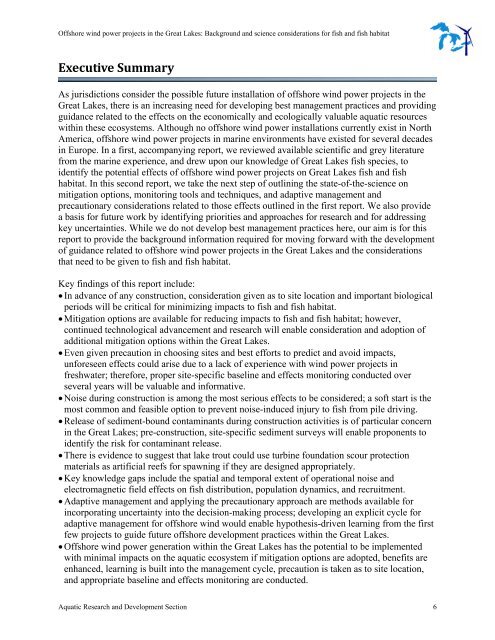Offshore Wind Power Projects in the Great Lakes - Ministry of ...
Offshore Wind Power Projects in the Great Lakes - Ministry of ...
Offshore Wind Power Projects in the Great Lakes - Ministry of ...
You also want an ePaper? Increase the reach of your titles
YUMPU automatically turns print PDFs into web optimized ePapers that Google loves.
<strong>Offshore</strong> w<strong>in</strong>d power projects <strong>in</strong> <strong>the</strong> <strong>Great</strong> <strong>Lakes</strong>: Background and science considerations for fish and fish habitat<br />
Executive Summary<br />
As jurisdictions consider <strong>the</strong> possible future <strong>in</strong>stallation <strong>of</strong> <strong>of</strong>fshore w<strong>in</strong>d power projects <strong>in</strong> <strong>the</strong><br />
<strong>Great</strong> <strong>Lakes</strong>, <strong>the</strong>re is an <strong>in</strong>creas<strong>in</strong>g need for develop<strong>in</strong>g best management practices and provid<strong>in</strong>g<br />
guidance related to <strong>the</strong> effects on <strong>the</strong> economically and ecologically valuable aquatic resources<br />
with<strong>in</strong> <strong>the</strong>se ecosystems. Although no <strong>of</strong>fshore w<strong>in</strong>d power <strong>in</strong>stallations currently exist <strong>in</strong> North<br />
America, <strong>of</strong>fshore w<strong>in</strong>d power projects <strong>in</strong> mar<strong>in</strong>e environments have existed for several decades<br />
<strong>in</strong> Europe. In a first, accompany<strong>in</strong>g report, we reviewed available scientific and grey literature<br />
from <strong>the</strong> mar<strong>in</strong>e experience, and drew upon our knowledge <strong>of</strong> <strong>Great</strong> <strong>Lakes</strong> fish species, to<br />
identify <strong>the</strong> potential effects <strong>of</strong> <strong>of</strong>fshore w<strong>in</strong>d power projects on <strong>Great</strong> <strong>Lakes</strong> fish and fish<br />
habitat. In this second report, we take <strong>the</strong> next step <strong>of</strong> outl<strong>in</strong><strong>in</strong>g <strong>the</strong> state-<strong>of</strong>-<strong>the</strong>-science on<br />
mitigation options, monitor<strong>in</strong>g tools and techniques, and adaptive management and<br />
precautionary considerations related to those effects outl<strong>in</strong>ed <strong>in</strong> <strong>the</strong> first report. We also provide<br />
a basis for future work by identify<strong>in</strong>g priorities and approaches for research and for address<strong>in</strong>g<br />
key uncerta<strong>in</strong>ties. While we do not develop best management practices here, our aim is for this<br />
report to provide <strong>the</strong> background <strong>in</strong>formation required for mov<strong>in</strong>g forward with <strong>the</strong> development<br />
<strong>of</strong> guidance related to <strong>of</strong>fshore w<strong>in</strong>d power projects <strong>in</strong> <strong>the</strong> <strong>Great</strong> <strong>Lakes</strong> and <strong>the</strong> considerations<br />
that need to be given to fish and fish habitat.<br />
Key f<strong>in</strong>d<strong>in</strong>gs <strong>of</strong> this report <strong>in</strong>clude:<br />
• In advance <strong>of</strong> any construction, consideration given as to site location and important biological<br />
periods will be critical for m<strong>in</strong>imiz<strong>in</strong>g impacts to fish and fish habitat.<br />
• Mitigation options are available for reduc<strong>in</strong>g impacts to fish and fish habitat; however,<br />
cont<strong>in</strong>ued technological advancement and research will enable consideration and adoption <strong>of</strong><br />
additional mitigation options with<strong>in</strong> <strong>the</strong> <strong>Great</strong> <strong>Lakes</strong>.<br />
• Even given precaution <strong>in</strong> choos<strong>in</strong>g sites and best efforts to predict and avoid impacts,<br />
unforeseen effects could arise due to a lack <strong>of</strong> experience with w<strong>in</strong>d power projects <strong>in</strong><br />
freshwater; <strong>the</strong>refore, proper site-specific basel<strong>in</strong>e and effects monitor<strong>in</strong>g conducted over<br />
several years will be valuable and <strong>in</strong>formative.<br />
• Noise dur<strong>in</strong>g construction is among <strong>the</strong> most serious effects to be considered; a s<strong>of</strong>t start is <strong>the</strong><br />
most common and feasible option to prevent noise-<strong>in</strong>duced <strong>in</strong>jury to fish from pile driv<strong>in</strong>g.<br />
• Release <strong>of</strong> sediment-bound contam<strong>in</strong>ants dur<strong>in</strong>g construction activities is <strong>of</strong> particular concern<br />
<strong>in</strong> <strong>the</strong> <strong>Great</strong> <strong>Lakes</strong>; pre-construction, site-specific sediment surveys will enable proponents to<br />
identify <strong>the</strong> risk for contam<strong>in</strong>ant release.<br />
• There is evidence to suggest that lake trout could use turb<strong>in</strong>e foundation scour protection<br />
materials as artificial reefs for spawn<strong>in</strong>g if <strong>the</strong>y are designed appropriately.<br />
• Key knowledge gaps <strong>in</strong>clude <strong>the</strong> spatial and temporal extent <strong>of</strong> operational noise and<br />
electromagnetic field effects on fish distribution, population dynamics, and recruitment.<br />
• Adaptive management and apply<strong>in</strong>g <strong>the</strong> precautionary approach are methods available for<br />
<strong>in</strong>corporat<strong>in</strong>g uncerta<strong>in</strong>ty <strong>in</strong>to <strong>the</strong> decision-mak<strong>in</strong>g process; develop<strong>in</strong>g an explicit cycle for<br />
adaptive management for <strong>of</strong>fshore w<strong>in</strong>d would enable hypo<strong>the</strong>sis-driven learn<strong>in</strong>g from <strong>the</strong> first<br />
few projects to guide future <strong>of</strong>fshore development practices with<strong>in</strong> <strong>the</strong> <strong>Great</strong> <strong>Lakes</strong>.<br />
• <strong>Offshore</strong> w<strong>in</strong>d power generation with<strong>in</strong> <strong>the</strong> <strong>Great</strong> <strong>Lakes</strong> has <strong>the</strong> potential to be implemented<br />
with m<strong>in</strong>imal impacts on <strong>the</strong> aquatic ecosystem if mitigation options are adopted, benefits are<br />
enhanced, learn<strong>in</strong>g is built <strong>in</strong>to <strong>the</strong> management cycle, precaution is taken as to site location,<br />
and appropriate basel<strong>in</strong>e and effects monitor<strong>in</strong>g are conducted.<br />
Aquatic Research and Development Section 6
















